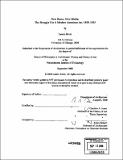New races, new media : the struggle for a modern American art, 1890-1925
Author(s)
Kroiz, Lauren
DownloadFull printable version (87.52Mb)
Alternative title
Struggle for a modern American art, 1890-1925
Other Contributors
Massachusetts Institute of Technology. Dept. of Architecture.
Advisor
Caroline A. Jones.
Terms of use
Metadata
Show full item recordAbstract
American modernism was formulated at the turn of the twentieth century, when artists and intellectuals became newly self-conscious of their aesthetic strategies in a rapidly urbanizing United States. During that same period, new immigrants from Southern and Eastern Europe poured into the U.S., native-born black and white Americans undertook internal migrations to northern cities, and advances in the technology of image making - photography, film, and even improvements in the graphic reproduction of caricature in newspapers - provoked uncertainty in the art world. This dissertation explores the intersections of these two trajectories in period artworks and debates about artistic medium, examining how notions of America as a diverse nation operated at an aesthetic and a cultural level.The immigrant critics and practitioners at the center of my study - Japanese-German critic Sadakichi Hartmann, Mexican-born artist Marius De Zayas, and English-Sri Lankan curator Ananda K. Coomaraswamy - each formed conflicted partnerships with the American photographer Alfred Stieglitz. These allies attacked America's homogeneous arts, positioning themselves as critical hybrid outsiders, and identifying marginal media as means by which to devise and theorize a new art in the U.S. This dissertation examines three episodes in their formulation of American modernism, arguing that each aesthetic breakthrough informed and was informed by a double debate: one occurring in the political and cultural sphere, and a parallel discourse about artistic media themselves. (cont.) Part one traces the origins of "straight" photography in relation to the nascent philosophy of cultural pluralism (1895-1907); part two explores caricature's role as a hybrid medium for negotiating between African and modern European art (1907-1917); and part three examines how the motion picture served to engage both popular white nativism and avant-garde celebration of ethnic spiritualism (1917-1925). With independent expressive properties, each art form could restructure the artistic canon and enable the formulation of what I term a "composite" American modernism.Formalist criticism has used medium specificity to isolate the study of art from other modes of history writing, but this dissertation restores a crucial historical context for modernist media theory to reveal that the ongoing American dilemma of integrating difference lies at the heart of American modernism.
Description
Thesis (Ph. D.)--Massachusetts Institute of Technology, Dept. of Architecture, 2008. Includes bibliographical references (p. 347-369).
Date issued
2008Department
Massachusetts Institute of Technology. Department of ArchitecturePublisher
Massachusetts Institute of Technology
Keywords
Architecture.